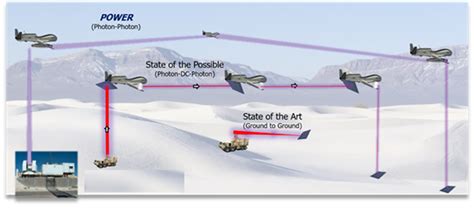
DARPA has achieved a significant breakthrough in wireless power transmission, successfully sending energy over five miles and even popping popcorn in the process, marking a major step forward in the agency’s efforts to revolutionize military logistics and capabilities.
The U.S. Defense Advanced Research Projects Agency (DARPA) recently announced the successful completion of a long-range wireless power transmission demonstration, achieving the milestone of transmitting usable energy over a distance exceeding five miles (approximately 10 kilometers). The experiment, part of DARPA’s Persistent Optical Wireless Energy Relay (POWER) program, not only demonstrated the feasibility of long-range wireless power transfer but also showcased its practical applications by using the transmitted energy to power a popcorn machine, dramatically illustrating the potential for remotely powering devices and equipment in challenging environments. This development could reshape military operations, humanitarian aid efforts, and numerous commercial applications by offering a reliable and efficient means of delivering power to areas lacking traditional infrastructure.
The POWER program, launched several years ago, aims to create a system capable of delivering power wirelessly over significant distances using lasers. The recent demonstration involved converting electricity into a laser beam, transmitting the beam through the air, and then converting it back into electricity at the receiving end. According to DARPA, the ability to wirelessly transmit power over long distances could eliminate the need for heavy and cumbersome batteries or fuel convoys, offering significant logistical advantages for military personnel operating in remote or contested areas.
“The POWER program has achieved a significant milestone in demonstrating the feasibility of long-range wireless power transmission,” stated Paul Jaffe, the POWER program manager. “This breakthrough could revolutionize military logistics by enabling the delivery of power to remote locations without the need for traditional infrastructure.”
The success of the POWER program demonstration has garnered considerable attention from both the military and the commercial sectors. The ability to wirelessly transmit power over long distances could have a wide range of applications, including:
-
Military Operations: Providing power to forward operating bases, unmanned aerial vehicles (UAVs), and dismounted soldiers in remote areas.
-
Humanitarian Aid: Delivering power to disaster-stricken areas where traditional infrastructure has been damaged or destroyed.
-
Commercial Applications: Powering remote sensors, electric vehicles, and other devices in areas where it is difficult or expensive to install traditional power lines.
-
Space Exploration: Enabling the transmission of power from solar power satellites to Earth or to spacecraft operating in deep space.
Technical Details and Challenges
While the concept of wireless power transmission has been around for over a century, achieving long-range transmission with sufficient efficiency and safety has been a significant challenge. DARPA’s POWER program addressed these challenges by using advanced laser technology and sophisticated beamforming techniques.
The system works by converting electricity into a high-intensity laser beam. This beam is then directed through the air to a receiver, which converts the laser light back into electricity. The key to the system’s success lies in its ability to focus the laser beam tightly on the receiver, minimizing energy loss and ensuring that the beam remains within safe limits.
However, there are still several challenges that need to be addressed before the technology can be widely deployed. One of the main challenges is atmospheric attenuation, which can cause the laser beam to weaken as it travels through the air. This is especially problematic in areas with high levels of humidity, dust, or other particles in the atmosphere.
Another challenge is safety. High-intensity laser beams can be dangerous to humans and animals, so it is important to ensure that the beam is contained and that there is no risk of accidental exposure. DARPA has implemented several safety measures to mitigate this risk, including:
-
Using a laser wavelength that is less harmful to the eyes.
-
Implementing a beam steering system that can quickly shut off the laser if it detects an obstruction in the beam’s path.
-
Establishing exclusion zones around the transmitter and receiver to prevent unauthorized access.
Future Directions
Despite the challenges, DARPA is optimistic about the future of wireless power transmission. The agency is currently working on improving the efficiency and range of the POWER system, as well as developing new safety measures to ensure that the technology can be deployed safely and reliably.
One of the key areas of research is the development of more efficient laser diodes. Laser diodes are the devices that convert electricity into laser light, and their efficiency is a major factor in the overall efficiency of the wireless power transmission system. DARPA is also exploring the use of different laser wavelengths, as well as new beamforming techniques that can help to reduce atmospheric attenuation.
In addition to improving the technology itself, DARPA is also working on developing new applications for wireless power transmission. The agency is currently collaborating with several companies to explore the use of the POWER system for powering unmanned aerial vehicles (UAVs), remote sensors, and other devices.
The success of DARPA’s POWER program represents a significant step forward in the development of wireless power transmission technology. While there are still challenges to be addressed, the potential benefits of this technology are enormous. Wireless power transmission could revolutionize military logistics, humanitarian aid efforts, and numerous commercial applications by offering a reliable and efficient means of delivering power to areas lacking traditional infrastructure.
Implications for Military and Civilian Sectors
The ramifications of DARPA’s wireless power leap extend far beyond merely popping popcorn. The ability to deliver power wirelessly across significant distances has profound implications for both the military and civilian sectors, promising to reshape operations, logistics, and infrastructure development.
-
Military Advantages: The most immediate impact is on military logistics. Currently, supplying forward operating bases (FOBs) and remote units with power is a costly and dangerous undertaking. Fuel convoys are vulnerable to attack, and the weight of batteries limits the mobility of soldiers. Wireless power transmission could eliminate the need for these vulnerable supply lines, significantly reducing risk and cost. UAVs could be powered continuously from a ground station, greatly extending their operational range and endurance. Soldiers could carry lighter loads, relying on wireless power to operate their equipment. This enhanced operational flexibility and reduced logistical burden could be a game-changer in modern warfare. The ability to rapidly deploy and power temporary communication hubs in disaster zones or conflict areas is another significant advantage.
-
Humanitarian Relief: In the aftermath of natural disasters, power grids are often damaged or destroyed, leaving communities without access to essential services. Wireless power transmission could provide a rapid and reliable means of restoring power to hospitals, emergency shelters, and communication centers. Relief workers could quickly deploy mobile power transmitters to deliver electricity to affected areas, enabling rescue operations and providing essential support to survivors. The ability to power water purification systems and medical equipment in remote or disaster-stricken areas could save lives and alleviate suffering.
-
Commercial Applications: The commercial applications of wireless power transmission are equally vast and transformative. Remote sensors used in agriculture, environmental monitoring, and infrastructure management could be powered wirelessly, eliminating the need for battery replacements and reducing maintenance costs. Electric vehicles could be charged wirelessly while driving on highways or parked in designated areas, extending their range and making them more convenient to use. Remote communities that lack access to traditional power grids could be powered by wireless transmission, bringing electricity and economic opportunity to underserved populations. The development of space-based solar power stations, which could beam energy wirelessly to Earth, could provide a clean and sustainable source of energy for the entire planet.
-
Infrastructure Development: Wireless power transmission could revolutionize infrastructure development by eliminating the need for expensive and time-consuming power line construction. In remote or difficult terrain, where building power lines is impractical or cost-prohibitive, wireless power transmission could provide a more efficient and economical solution. This could open up new opportunities for development in areas that were previously inaccessible due to lack of power. The technology could also be used to power offshore platforms, remote mining operations, and other industrial facilities.
Challenges and Considerations
Despite the significant potential benefits of wireless power transmission, there are also several challenges and considerations that need to be addressed before the technology can be widely deployed.
-
Efficiency: The efficiency of wireless power transmission is a critical factor in its economic viability. Energy is lost during the conversion of electricity to laser light, the transmission of the laser beam through the atmosphere, and the reconversion of laser light back to electricity. Improving the efficiency of each of these steps is essential to reducing the overall cost of the technology. Research is ongoing to develop more efficient laser diodes, beamforming techniques, and receiver technologies.
-
Safety: The safety of wireless power transmission is paramount. High-intensity laser beams can be dangerous to humans and animals, so it is important to ensure that the beam is contained and that there is no risk of accidental exposure. Safety measures include using laser wavelengths that are less harmful to the eyes, implementing beam steering systems that can quickly shut off the laser if they detect an obstruction in the beam’s path, and establishing exclusion zones around the transmitter and receiver. Public education and awareness campaigns are also important to ensure that people understand the risks and take appropriate precautions.
-
Atmospheric Attenuation: Atmospheric attenuation can cause the laser beam to weaken as it travels through the air, reducing the amount of energy that reaches the receiver. This is especially problematic in areas with high levels of humidity, dust, or other particles in the atmosphere. Research is ongoing to develop beamforming techniques that can compensate for atmospheric attenuation, as well as to identify laser wavelengths that are less susceptible to atmospheric absorption.
-
Regulatory Issues: The deployment of wireless power transmission technology will require the establishment of regulatory frameworks to ensure its safe and responsible use. These frameworks will need to address issues such as licensing, frequency allocation, safety standards, and environmental impact. International cooperation will be essential to ensure that these frameworks are consistent across different countries and regions.
-
Public Acceptance: Public acceptance is crucial for the successful adoption of any new technology. Some people may be concerned about the potential health risks of exposure to laser beams, while others may be wary of the aesthetic impact of large transmission towers. Addressing these concerns through public education and outreach is essential to building trust and ensuring that the technology is widely accepted.
Frequently Asked Questions (FAQs)
-
How does DARPA’s wireless power transmission system work?
The system converts electricity into a high-intensity laser beam, transmits the beam through the air, and then converts it back into electricity at the receiving end. This process involves sophisticated beamforming techniques to focus the laser beam and minimize energy loss.
-
What are the main challenges of wireless power transmission?
The main challenges include efficiency losses during energy conversion, atmospheric attenuation (weakening of the laser beam by the atmosphere), and safety concerns related to the high-intensity laser beams.
-
What are the potential applications of this technology?
Potential applications include powering remote military bases, providing humanitarian aid in disaster areas, charging electric vehicles wirelessly, powering remote sensors, and enabling space-based solar power transmission.
-
How safe is the laser beam used in the system?
DARPA has implemented several safety measures to mitigate the risk of accidental exposure, including using a laser wavelength that is less harmful to the eyes, implementing a beam steering system that can quickly shut off the laser if it detects an obstruction, and establishing exclusion zones around the transmitter and receiver.
-
What are the next steps for the POWER program?
DARPA is currently working on improving the efficiency and range of the POWER system, as well as developing new safety measures and exploring new applications for wireless power transmission, including collaborations with companies to power UAVs and remote sensors.
Detailed Analysis of Key Components and Innovations
The success of DARPA’s POWER program is not merely a result of a single breakthrough, but rather a culmination of innovations across several key components of the wireless power transmission system. A closer examination of these components reveals the ingenuity and technical advancements that have made this long-range power transfer a reality.
-
Laser Diode Technology: The heart of the POWER system lies in its laser diode technology. Laser diodes are semiconductor devices that convert electrical energy directly into light. The efficiency of this conversion is crucial to the overall efficiency of the wireless power transmission system. DARPA has been investing in research and development to improve the efficiency of laser diodes, focusing on materials science and device design. Higher efficiency laser diodes not only reduce energy losses but also minimize heat generation, which can further improve the reliability and longevity of the system. Furthermore, the specific wavelength of the laser diode is carefully selected to minimize absorption by atmospheric gases and particles, optimizing the transmission range.
-
Beamforming and Steering Technology: Maintaining a focused and stable laser beam over long distances requires sophisticated beamforming and steering technology. Beamforming involves precisely controlling the phase and amplitude of the laser light emitted from multiple laser diodes to create a highly collimated beam. This collimated beam can then be steered in real-time to compensate for atmospheric turbulence, wind, and other disturbances. DARPA’s POWER program has developed advanced algorithms and hardware to achieve precise beam control, ensuring that the laser beam remains tightly focused on the receiver, even over distances of several miles. The steering mechanism also incorporates safety features, such as the ability to automatically shut off the laser if an obstruction is detected in the beam’s path.
-
Photovoltaic Receiver Technology: At the receiving end of the wireless power transmission system, a photovoltaic receiver converts the laser light back into electricity. The efficiency of this conversion is another critical factor in the overall system performance. DARPA has been exploring the use of advanced photovoltaic materials and device designs to maximize the efficiency of the receiver. These materials include multi-junction solar cells, which are capable of absorbing light over a wider range of wavelengths than traditional silicon solar cells. The design of the receiver also incorporates features to minimize reflection and scattering of the laser light, ensuring that as much of the incident energy as possible is converted into electricity.
-
Atmospheric Compensation Techniques: One of the major challenges of long-range wireless power transmission is atmospheric attenuation. As the laser beam travels through the air, it can be absorbed, scattered, and distorted by atmospheric gases, particles, and turbulence. DARPA’s POWER program has developed several innovative techniques to compensate for these effects. Adaptive optics systems are used to correct for atmospheric turbulence in real-time, improving the beam quality and reducing energy losses. Furthermore, the system incorporates sensors that monitor atmospheric conditions and adjust the laser beam parameters accordingly. These sensors can detect changes in humidity, temperature, and wind speed, allowing the system to dynamically optimize its performance.
-
Safety Systems and Protocols: Safety is a paramount concern in the design and operation of the POWER system. Multiple layers of safety measures are implemented to prevent accidental exposure to the laser beam. These measures include:
-
Wavelength Selection: The laser wavelength is chosen to minimize the risk of eye damage.
-
Beam Steering and Shut-off System: A sophisticated beam steering system is used to keep the laser beam tightly focused on the receiver. If an obstruction is detected in the beam’s path, the laser is automatically shut off.
-
Exclusion Zones: Exclusion zones are established around the transmitter and receiver to prevent unauthorized access.
-
Public Awareness Campaigns: Public awareness campaigns are conducted to educate people about the technology and its potential risks.
-
Comparison with Existing Wireless Power Technologies
It is important to distinguish DARPA’s POWER program from other existing wireless power technologies, such as inductive charging and microwave power transfer. Inductive charging, commonly used for charging smartphones and other small devices, relies on magnetic fields to transfer energy over very short distances (typically a few millimeters). Microwave power transfer can transmit energy over longer distances, but it is less efficient and requires large antennas.
DARPA’s POWER program represents a significant advance over these existing technologies in terms of range, efficiency, and safety. By using laser beams, the POWER system can transmit energy over distances of several miles with relatively high efficiency. Furthermore, the use of advanced beamforming and safety techniques ensures that the laser beam is contained and that there is no risk of accidental exposure.
Ethical Considerations
As with any new technology, the development and deployment of wireless power transmission raise several ethical considerations. These considerations include:
-
Potential for misuse: The technology could be used for military purposes, such as powering weapons systems or surveillance devices. It is important to ensure that the technology is used responsibly and ethically.
-
Environmental impact: The production and deployment of the technology could have environmental impacts, such as the consumption of resources and the generation of waste. It is important to minimize these impacts and to ensure that the technology is sustainable.
-
Social equity: The benefits of the technology should be shared equitably across society. It is important to ensure that the technology is accessible to all, regardless of their socioeconomic status.
Conclusion
DARPA’s successful demonstration of long-range wireless power transmission represents a significant technological achievement with potentially transformative implications for military operations, humanitarian aid, and commercial applications. While challenges remain in terms of efficiency, safety, and regulatory frameworks, the potential benefits of this technology are enormous. As research and development continue, wireless power transmission could become a ubiquitous feature of our lives, enabling a new era of connectivity and powering a more sustainable future. The ability to pop popcorn five miles away is a symbolic demonstration of a technology that could revolutionize how we power the world. The POWER program is not just about transmitting energy; it’s about transmitting possibilities.









